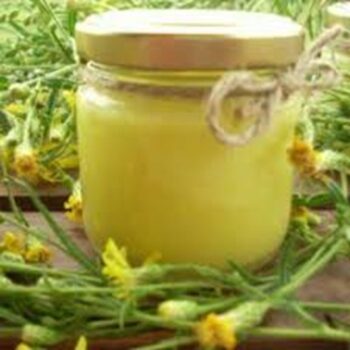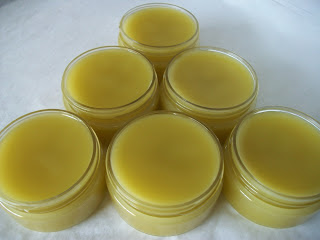Beeswax Creams and Ointments
Beeswax creams and ointments
There is frequently a great lack of personal cosmetic and local medicinal products in many rural areas – they are too expensive for many women to buy – and so this value added activity has the potential to be a useful domestic product as well as a lasting and lucrative home industry. As production skills and good packaging develop these products can be taken to more distant markets.
Bees wax is an important component of creams, ointments and lotions because the unique characteristics of beeswax give solidity to emulsified solutions and increase the water holding capacity of ointments and creams. In many developing countries the sophisticated ingredients, rose water, olive oil etc. that area mentioned in books designed for people in developing countries are not available so the basic recipes offered are based on ingredients that are normally available. Additions of medicinal ingredients, colourings or perfumes can be added to the basic recipes with the number of products only limited by the imagination of the producer. In the west, where allergies are common, it is usually the addition of perfume, colouring, essential oils or lanolin that cause skin irritation.
Since ancient times the basic recipe for creams and ointments has been a mixture of oils and beeswax in proportions that reflect the desired end consistency. Today’s industrial processes have made industrial cosmetics using different processes. However, there are two types of creams that is possible for home producers to make. There are oily creams and soft creams. The oily creams are a mixture of oils only and so are very easy to make. This type of cream can set quite hard (depending on the amount of beeswax used) and is not so light as the emulsified creams. They make very useful products such as lip balms, hand and body creams and barrier creams. They are especially good as foot creams in the dry season when skin can quickly start to crack.
Oily cream basic recipe
1 measure beeswax; 4 measures Vaseline; 4 measures of oil
Heat all the ingredients together in a double boiler.
Stir thoroughly.
Remove from the heat and add any coloring, perfume or medicinal extracts that have been planned into the mixture.
Stir thoroughly again and pour into the sales container while still warm.
For softer cream add more oil; for harder cream use less oil. The addition of a few drops of glycerine will make the cream softer also.
Oils can be vegetable, ground nut oil (some people have developed allergies to peanuts (refined) palm oil or filtered castor oil. In each country there will be variation on the types of oil easily available. For instance some places may have shea butter or coconut oil. It is wise for potential cosmetic producers to look for suitable local ingredients that are available at a reasonable cost so that the resulting creams can be sold profitably. In many places palm oil will be available. Be warned though – using unrefined palm oil will make the cream look very red although this colouration does not stain skin or clothes. A good rule of thumb when making cosmetics is to use food quality oils. If it can be safely eaten it will be safe to put on the skin.
Herbs, propolis, lemon grass, aloe vera, vetiver root, herbal oil extracts, essential oils or honey can be added for specific medical or cosmetic uses: for instance, eucalyptus for chest and nasal congestion. A reasonable quantity of essential oils can be extracted from suitable plants and herbs by packing them tightly into good quality oil (vegetable or coconut is preferred) and then baked in a closed container in a very cool oven – (max 100C) for 2-3 hours.
Soft cream – or ointment
The soft body creams are a mixture of oils, including beeswax, and water. Oils and water don’t normally mix so in order to join these otherwise incompatible ingredients together an emulsifier is used. If a suitable emulsifier can be found then this is a more economic product to make as it includes a significant quantity of water which is an inexpensive ingredient. It is important to get the ingredients all at the same temperature before combining.
Soft cream basic recipe
½ measure melted beeswax measure Vaseline measure vegetable oil,
2 measures scented or herbal water teaspoon borax (sodium borate)
Prepare a pot of boiling water over the fire
In a clean tin put all the ingredients except the water
Heat the tin until all the oils and wax are melted together
In a second clean tin mix the borax with the scented/herbal water. Scented or herbal water is obtained by boiling herbs or leaves in the water first then straining is carefully)
Heat the tin in the double boiler until the wax mixture is ready
The temperature of the liquids in both containers should be the same
Prepare a clean tin and stirrer
At this point you may need a helper
Remove the wax tin from the heat and tip all the melted wax and oils into the container
Very quickly pour the scented water mixture into the wax mixture stirring continuously without stopping until the mixture becomes thick
Put into small pots for sale before it cools
This body cream can be made very much more liquid – and can be called a lotion – by the addition of ethyl alcohol and stirring well as the mixture is beginning to set. The amount of alcohol added will be determined by how liquid the resulting lotion is required to be and how long it is to be stored as the alcohol may evaporate if the storage is not cool. Too much alcohol will dry the skin. It is recommended that the alcohol be diluted to no more than 50% strength using distilled water.
Making creams without using an emulsifier
The writer has tried two methods to make soft cream without borax as an emulsifier. Both work but neither has shown very satisfactory results. Maybe some experimental people might like to try and pots the results on this website. The first method is to use the recipe given above but with a much smaller quantity of water (2/3rd of a measure instead of 2 measures). This is blended slowly into the wax mixture beating hard and constantly until the mixture has emulsified. This works well at the start but does not appear to be stable over time. The second method is to use a biological emulsifier such as gelatine. This can either be purchased or derived form animal parts. Again it works very well at the start but the cream quickly goes mouldy.
This means that the mixture needs a suitable preservative. The writer has considered salt but has not experimented with this. Some countries may require ingredient safety data sheets and ingredients list if cosmetics are to be sold on a large scale.




Add comment